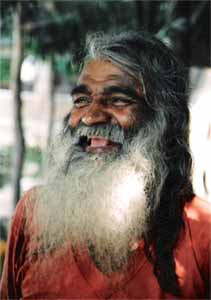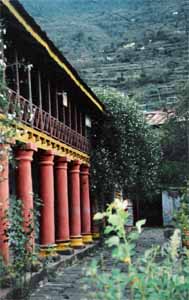
A Stay in India (4): Adventures in Rishikesh And Joshimath
Maharishi's academy sits beyond the built-up ashram area of Rishikesh, on a quiet wooded ridge adjoining the deep forest of a national park. As Westerners, we are not allowed inside, and so we wander to the bank of the river below, where we find a rustic structure of red brick. Inside is a robust man of perhaps 60 with long hair and beard, in a saffron T-shirt and short dhoti, doing brickwork with some other sanyasis, expanding this dharamsala that he has built to accommodate traveling seekers and saints. This is Brahmacharya Direndra, who spent time serving Maharishi in the days of the Beatles and Mia Farrow.
Recognizing a friend in our party, Direndra greets us with his infectious laugh, throwing back his head and opening his mouth wide in his mirth. His English is limited, but we get him talking about old times. "Meditation very powerful!" he says, laughing again. He retells the story of being thrown from a bus as it went over a steep mountain cliff. As the bus tumbled over, all he could think to do was to repeat his mantra. Ending in the river but not knowing how to swim, his salvation came in the form of a tire floating by. Then a little girl bobbed to the surface and threw her arms around his neck. Only the two of them survived.
I want to take his picture, but he asks me to wait, and emerges a minute later in a full saffron robe — 'OK now.' After the photos, he suddenly begins walking toward town, beckoning us to follow, through back ways and drainage ditches, until we arrive at a residential ashram. There on a porch sits an older woman, whom Direndra directly approaches. Before he introduces her, I suspect who this may be. I had twice been encouraged, before leaving on this journey, to seek out, in Rishikesh, a special woman known as Mataji, a close devotee of both Maharishi and his teacher Brahmananda Saraswati or "Guru Dev." And now, Direndra tells us, this is she. I am nudged, swelled by this small miracle. One of my fellow travelers, who had been living in India for five years, had visited Direndra many times but had never heard of Mataji; I had been told of her and desired to meet her, but had made no plans to find her.
Mataji speaks mostly Hindi, but in small bursts of English we discover that she traveled to Los Angeles with Maharishi in the 1950’s, and helped finance his first trip to the U.S. Before that she directly served Guru Dev, and was the first woman he initiated, in 1943. Direndra attempts to translate for us, but the result is mostly just Hindi to even more animated Hindi, and so for now any more elaborate stories cannot be retrieved.
Slipping into her rooms, Mataji emerges with bananas as prasad for us to eat. She invites us inside, asking that we wash our hands. There are two simple rooms, one filled by her bed and personal things, the other a small kitchen area. She shows us some special photographs that she keeps by her bed. Then she opens a large metal storage cabinet. On the bottom shelf is a beautiful shrine, carefully adorned, containing small pictures of Guru Dev, some fresh flowers, silk, and brass puja items. At the center lies a pair of wooden sandals. These, she says, are the last pair that Guru Dev wore; she was with him the day he died. With a graceful sweep of her hand, she invites me to squeeze into the space between the bed and the cabinet, my legs pushed under the bed frame, and I bend down to touch my forehead to the sandals, moved profoundly by the mystery, the surprise, this unexpectedly palpable sense of connection with Guru Dev.

Jyotir Math, just above the Himalayan town of Joshimath, is a marvelously attractive structure, built of wood, with a carved porch rail on the second floor supported by large pillars. Colored flags flutter in the wind on the open second-floor breezeway. Wildflower gardens extend for hundreds of feet around the building, and huge vines of fragrant jasmine climb the pillars.
As we enter the building, few people are in evidence, as the Shankaracharya himself is away. An older swami in saffron robes and a wool cap sits in the dimly lit main audience hall, and he leaves us alone to do our meditation program there in the silence. He stations himself just outside the hall like a sentry, and we hear him explain to a visitor that inside we are doing "dhyana".
The hall is suffused with the presence of Guru Dev. A shrine to his memory sits to one side of the carved wooden throne. On the wall to either side of the throne are large paintings of Shankara. All around the room, near the ceiling, are pictures of Shiva and Ram, of Guru Dev and other Shankaracharyas, and of Maharishi. Looking around this room, recalling what has transpired here for decades and centuries — the profundity of the teachings, the fullness of the silence — I feel a warmth of blessing and grace. Though tired from long travels over mountain roads, I experience more silence and vibrant clarity in meditation than I have in many years — as though I had reconnected directly to the source of this knowledge and this practice.
As we leave, a young boy doing chores points out the room that was Guru Dev’s sleeping quarters, and gazing up at the balcony in the dusk, we silently recall that Maharishi slept outside this doorway during his years of devoted service. My reverence, in this place, is complete.
